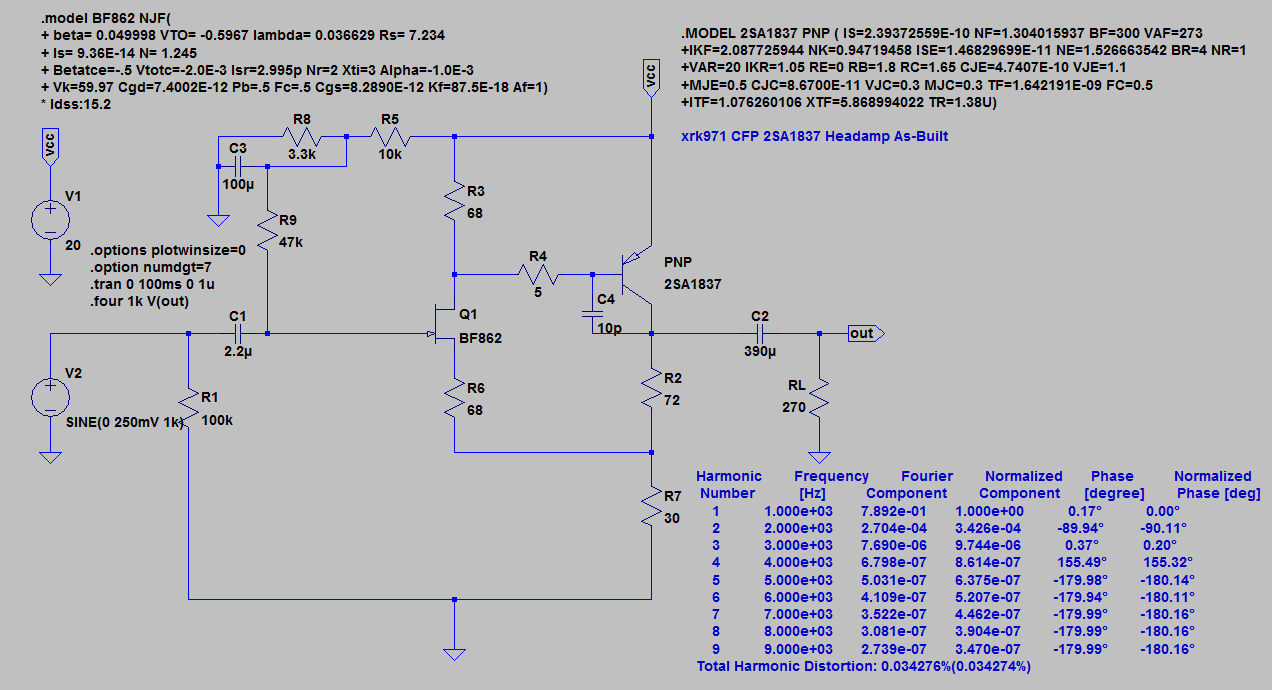Very good test. You can see why ask people about the sound quality even when they know the measured performance; the figures do not clearly show which HPA offers the best sound quality. You have to listen.
Thanks X.
Hugh
Thanks X.
Hugh
My choice is F and i audition the sample tracks through this HA that i have already built. Use this as a pre . i thought this HA produce the best timbre.
Thanks to xrk
Thanks to xrk
The results are very interesting. The 3 best clips for me were B (BF862-2SA1837), F (Pocket Class A) and H (the Super CMOY). Not sure why I liked the CMOY clip so much - maybe it has a bass boost like other cmoys. 🙂
So, it is very encouraging to know that these simple BF862 based circuits sound so good. The next step is to build one. Is this the schematic and start of the build thread for the BF862 - 2SA1837? Just replace the BD140 with a 2SA1837?
It would be great to start separate build threads for the different amps. As a newbie all the different schematics and cross references are confusing. It would also be great if the creators give their creations unique names - like Tiger-in-a-Tin, then we all know this is AKSA's BF862-2SA1837 HA and not the BF862-BD140 one.
Thank you X for all your effort. Keep us posted - especially on PCB's for the winner of this round.
So, it is very encouraging to know that these simple BF862 based circuits sound so good. The next step is to build one. Is this the schematic and start of the build thread for the BF862 - 2SA1837? Just replace the BD140 with a 2SA1837?
It would be great to start separate build threads for the different amps. As a newbie all the different schematics and cross references are confusing. It would also be great if the creators give their creations unique names - like Tiger-in-a-Tin, then we all know this is AKSA's BF862-2SA1837 HA and not the BF862-BD140 one.
Thank you X for all your effort. Keep us posted - especially on PCB's for the winner of this round.
My choice is F and i audition the sample tracks through this HA that i have already built. Use this as a pre . i thought this HA produce the best timbre.
Yes, I agree. It is my favorite too, even tho 'musically' B is the most 'foot tapping'.
G was the most distorted. I thought it was the pocket amp because imo 0.02% is too high already for a line amp. But surprisingly EUVL designed an SRPP with 0.25% THD? 😕 (Never heard a solid state SRPP before).
I have waited for this big reveal, to find out which amp F was. Because I thought that it's weakness can be fixed.
F strength is the correct timbre, the opposite of B. I love CFP amps like B because they are so enjoyable, but they change the music. F is not so enjoyable, so this is what should be fixed. Run more current (and voltage) on the ZVN, cascade the ZVN. When the current is high, it may not be a pocket amp anymore, but imho it is so potential that it should be done.
Yes, I agree. It is my favorite too, even tho 'musically' B is the most 'foot tapping'.
G was the most distorted. I thought it was the pocket amp because imo 0.02% is too high already for a line amp. But surprisingly EUVL designed an SRPP with 0.25% THD? 😕 (Never heard a solid state SRPP before).
I have waited for this big reveal, to find out which amp F was. Because I thought that it's weakness can be fixed.
F strength is the correct timbre, the opposite of B. I love CFP amps like B because they are so enjoyable, but they change the music. F is not so enjoyable, so this is what should be fixed. Run more current (and voltage) on the ZVN, cascade the ZVN. When the current is high, it may not be a pocket amp anymore, but imho it is so potential that it should be done.
The SRPP was perhaps the most complex amp with 4 pairs of BF862's on the output stage for current boost. Unfortunately - if not precisely matched, the THD will be high - and this is the design's main problem. You need about 100 BF862's to match 8 this precisely. So not the designers' fault.
Regarding F - it's raison d'etre is a pocket amp running on rechargeable 9v batteries. So increasing bias to maybe 65mA might be acceptable. Certain manipulations in the circuit may yield lower THD but I think it sounds quite nice as it is.
The results are very interesting. The 3 best clips for me were B (BF862-2SA1837), F (Pocket Class A) and H (the Super CMOY). Not sure why I liked the CMOY clip so much - maybe it has a bass boost like other cmoys. 🙂
So, it is very encouraging to know that these simple BF862 based circuits sound so good. The next step is to build one. Is this the schematic and start of the build thread for the BF862 - 2SA1837? Just replace the BD140 with a 2SA1837?
It would be great to start separate build threads for the different amps. As a newbie all the different schematics and cross references are confusing. It would also be great if the creators give their creations unique names - like Tiger-in-a-Tin, then we all know this is AKSA's BF862-2SA1837 HA and not the BF862-BD140 one.
Thank you X for all your effort. Keep us posted - especially on PCB's for the winner of this round.
Agdr's Super CMOY 1688 is not a CMOY other than it fits in tin. It's closer to a pocket O2 with true dual rail power supply and extensive power management and headphone protection from turn on thump. It's a very nice sounding amp given its opamp origins.
Thanks for submitting your guesses. You did well in identifying B and F - it looks like two transistor amps are in your future. 🙂
Although you did not guess 4 correctly, for the effort and getting two of the popular ones right I will get you a pocket amp PCB as a prize. Congratulations

The circuit for these are distributed throughout the "MOSFET Follower" thread. They are there thougnif you take the time to read. Post questions in the thread and I can assist you to find correct schematic.
Last edited:
Although you did not guess 4 correctly, for the effort and getting two of the popular ones right I will get you a pocket amp PCB as a prize. Congratulations
Well thank you very very much X!
 It is indeed a great prize since I missed the first GB - wanted to see the final results first.
It is indeed a great prize since I missed the first GB - wanted to see the final results first.es, I agree. It is my favorite too, even tho 'musically' B is the most 'foot tapping'.
I agree. There is something to the sound of B that makes it so engaging, lively.
Agdr's Super CMOY 1688 is not a CMOY other than it fits in tin. It's closer to a pocket O2 with true dual rail power supply and extensive power management and headphone protection from turn on thump. It's a very nice sounding amp given its opamp origins.
Sorry, it is OT - but I find it very interesting that it was the awareness of, and interest in getting a CMOY, just more than a year ago, that suddenly opened the world (and possibilities) of DIY to me. My interest lead me from CMOYs to O2s to Starving Students to Bottlehead Cracks to today. I never built a CMOY but could not have imagined that a year later I would be in a position to build something like a Class A headamp. Thank to all who share their knowledge, designs, findings and experiences on this forum.
I agree. There is something to the sound of B that makes it so engaging, lively.
I still don't know the 'secret sauce' of CFP design. Instead of finding out, I preferred to assume that it will not work the way I want it. But the B/C headamps are so simple that I think I will find out by building my versions soon.
I will also design clones of your headamp, except that I will use it to drive amplifier load. I have a lot of fancy JFETs and small signal Mosfets (but not the BF862 and the ZVN). I think I know already one secret: some small signal transistors like a certain low voltage around 9v-12v (even tho it can accept a much higher voltage). I think it is not shown in the Spice transistor models.
Thanks.
These work wonderfully as power amp preamps. In fact, my 2SA1837 CFP now serves as the preamp for my main power amp, the VHEX+. The plans are in this thread here:
http://www.diyaudio.com/forums/head...2-based-se-class-headamp-without-heat-31.html
Here is the 2SA1837 CFP amp:
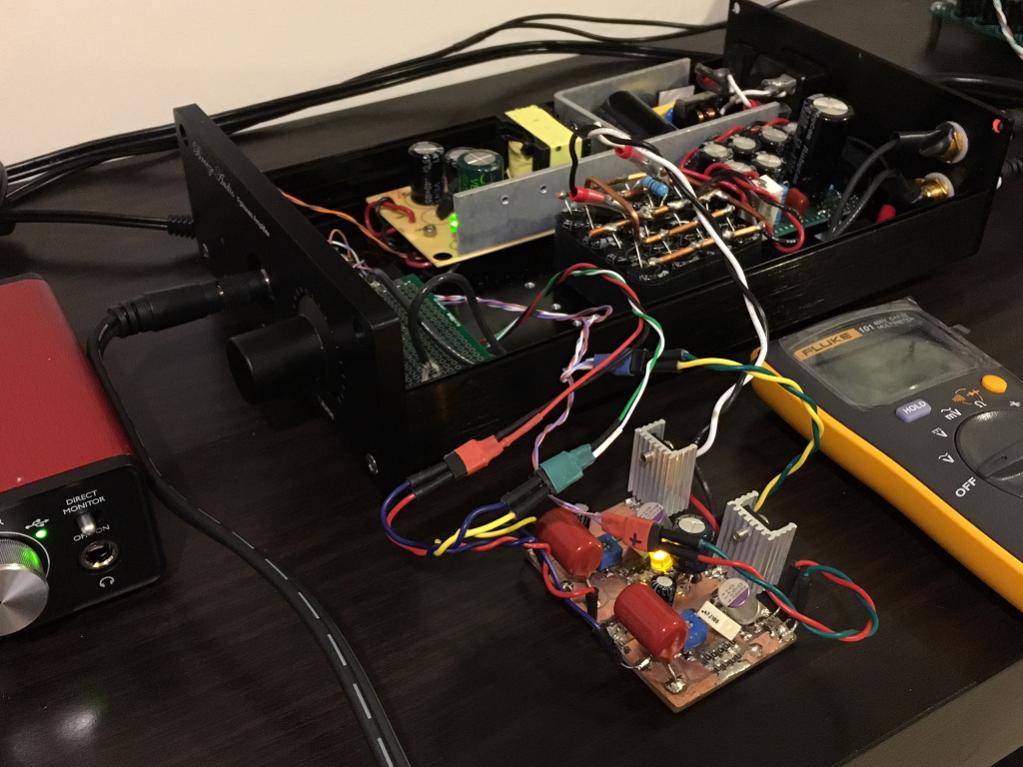
I used pots to match the harmonic distortion profiles on both channels:
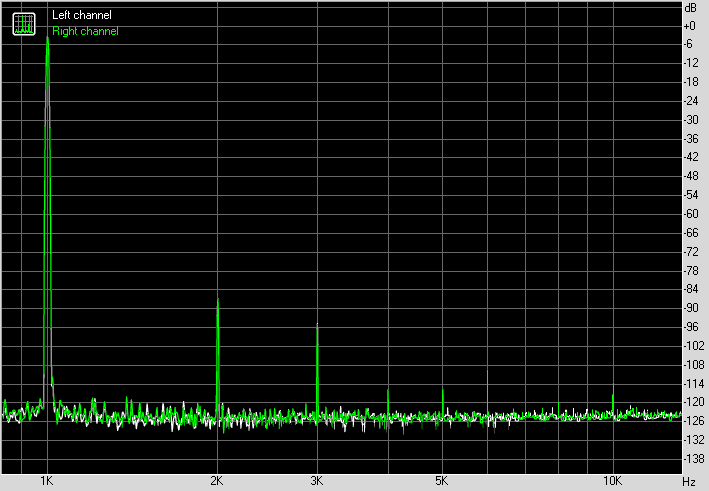
It's my reference amp:
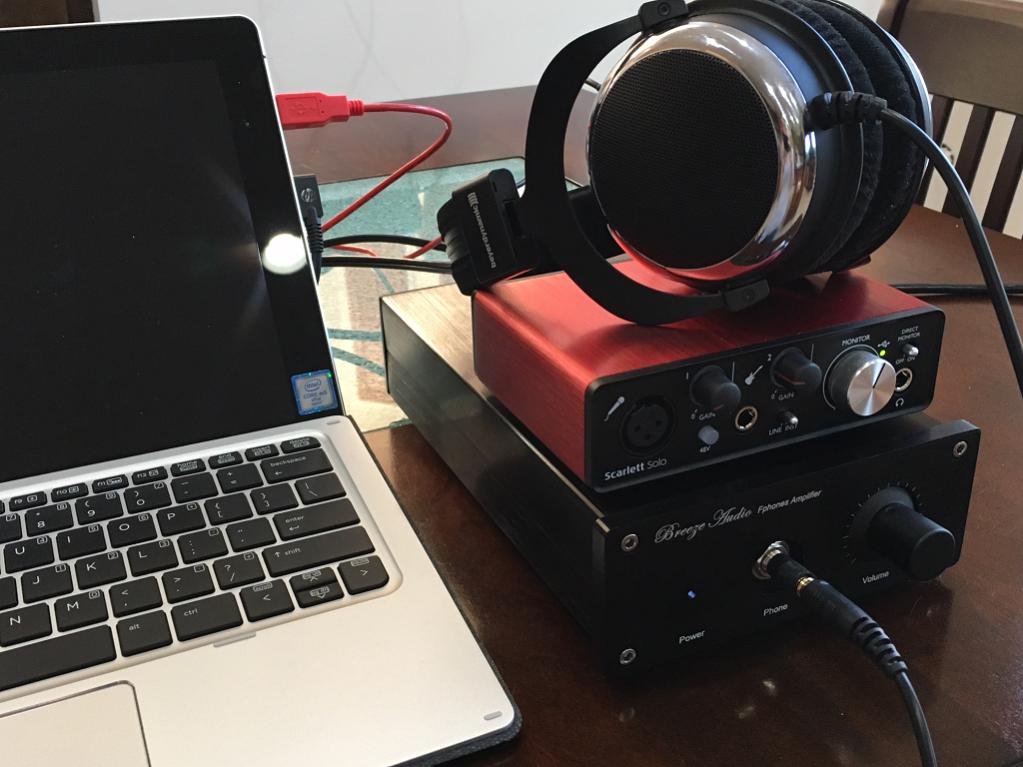
http://www.diyaudio.com/forums/head...2-based-se-class-headamp-without-heat-31.html
Here is the 2SA1837 CFP amp:

I used pots to match the harmonic distortion profiles on both channels:

It's my reference amp:

Last edited:
These work wonderfully as power amp preamps. In fact, my 2SA1837 CFP now serves as the preamp for my main power amp, the VHEX+. The plans are in this thread here:
http://www.diyaudio.com/forums/head...2-based-se-class-headamp-without-heat-31.html
Thanks, X. Is this schematic the one used for B in the test? In previous post I think I saw the measured distortion for B is 0.00 something but in your simulation it is 0.034% (0.25V input)? The 10pF compensation is used too??
How about the as-built schematic for amp C? It sounded a bit 'different' and I wish to find out why it is so.
Yes this is the amp B schematic as built. It actually measures lower distortion than the predicted simulation. Yes I used 10pF NP0 caps. Probably not absolutely necessary but our fhem in just in case as 2SA1837 has such high bandwidth.
Amp C is here - similar to B in topology:
http://www.diyaudio.com/forums/solid-state/301164-mosfet-source-follower-headamp-32.html
Hand drawn PCB:
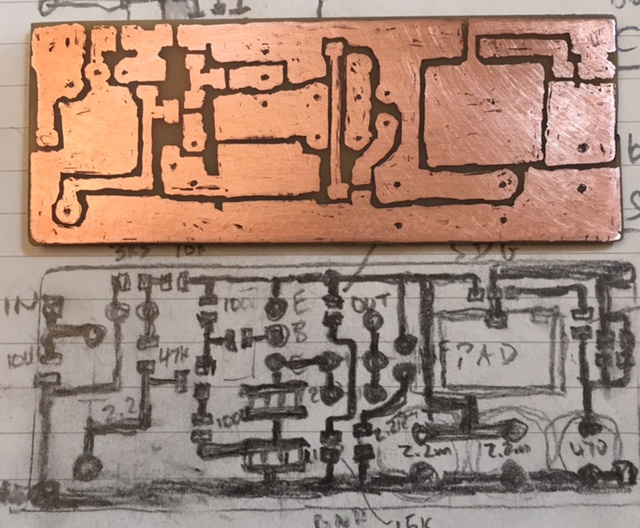
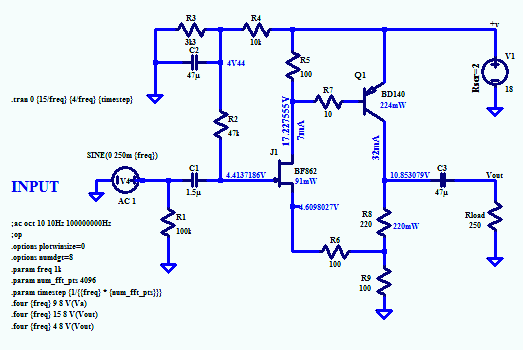
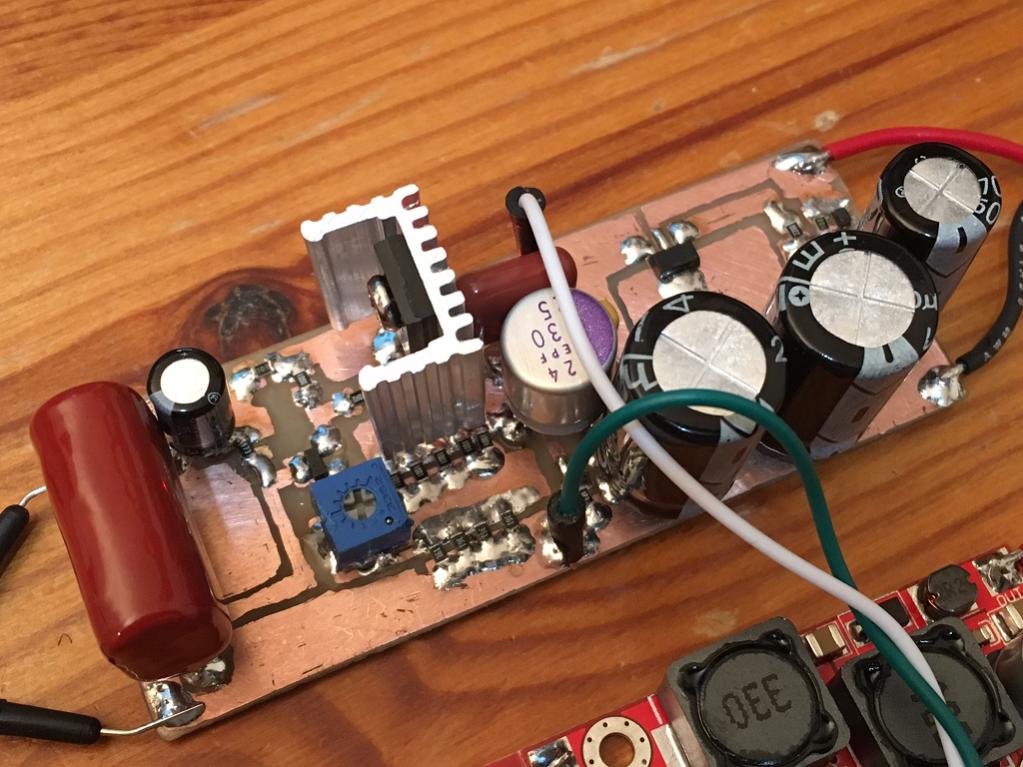
Tests here:
http://www.diyaudio.com/forums/solid-state/301164-mosfet-source-follower-headamp-33.html#post4971963
Amp C is here - similar to B in topology:
http://www.diyaudio.com/forums/solid-state/301164-mosfet-source-follower-headamp-32.html
Hand drawn PCB:



Tests here:
http://www.diyaudio.com/forums/solid-state/301164-mosfet-source-follower-headamp-33.html#post4971963
Last edited:
Yes I used 10pF NP0 caps. Probably not absolutely necessary but our fhem in just in case as 2SA1837 has such high bandwidth.
Amp C is here - similar to B in topology:
http://www.diyaudio.com/forums/solid-state/301164-mosfet-source-follower-headamp-32.html
May be what I perceived as wrong timbre is the effect of the 10pF? Who knows. It does sound like a phase issue. Amp C has similar topology but when I rated them based on a piano attack, I rated amp C second after amp F. So no such issue with C. (A and B were worst).
Well, I do tend to avoid such compensation scheme. Sometimes it is not possible with wide bandwidth amps but often there are scheme options such as a cap across feedback resistor or cap to ground or B+ or output, etc.
DD,
It is the harmonic profile, known as 'distortion'.
But you know that; if you can go into the THD, and analyse the harmonics and then set them into a FFT you can assess the 'sound' quality in a 'subjective' way.
After all, our hearing is rather subjective, and it's quite acute, a Strad always sounds better than a Suzuki....... and it comes back to the harmonic profile, aka 'timbre'.
Hugh
It is the harmonic profile, known as 'distortion'.
But you know that; if you can go into the THD, and analyse the harmonics and then set them into a FFT you can assess the 'sound' quality in a 'subjective' way.
After all, our hearing is rather subjective, and it's quite acute, a Strad always sounds better than a Suzuki....... and it comes back to the harmonic profile, aka 'timbre'.
Hugh
A close call
For me, it was a very close call. I listened to the clips many times.
My impression was B seemed to reproduce the complex harmonics and overtones of the piano better than the others, but G had authority on the lower end: the bass drum sounded more like a bass drum.
In the end, I voted for G.
Since I already have a G, I now need to build a B for comparison. X, there are quite a few schematics for B floating in different forums. Is this (post 301) the one used in this poll?
http://www.diyaudio.com/forums/head...2-based-se-class-headamp-without-heat-31.html
If so, would you be so kind as to post the LTSpice .asc file? I am not sure I can read the spice .model directives (text) in the jpg file. Or maybe post (or PM) the 2SA .model directive?
Thank you for taking time to do this.
For me, it was a very close call. I listened to the clips many times.
My impression was B seemed to reproduce the complex harmonics and overtones of the piano better than the others, but G had authority on the lower end: the bass drum sounded more like a bass drum.
In the end, I voted for G.
Since I already have a G, I now need to build a B for comparison. X, there are quite a few schematics for B floating in different forums. Is this (post 301) the one used in this poll?
http://www.diyaudio.com/forums/head...2-based-se-class-headamp-without-heat-31.html
If so, would you be so kind as to post the LTSpice .asc file? I am not sure I can read the spice .model directives (text) in the jpg file. Or maybe post (or PM) the 2SA .model directive?
Thank you for taking time to do this.
but G had authority on the lower end: the bass drum sounded more like a bass drum.
In the end, I voted for G.
How did you listen to the clips? May be if the voters listened to the clips through a wide band speaker, there would be more votes for G. I used headphone but I listened once using my speaker and I found one clip (not sure which one it is) had the characteristic of positive feedback amplifier.
This low bass authority is typical to amps with positive feedback. But they have a tendency to colour the sound, especially if there is not enough "damping" in the first place (so you use the feedback to increase the damping). ACA#1 is an example where I found that it is too coloured and even fatiguing. But if you listen to the low bass through a wide band 3-way speaker, hmm, it's so beautiful. It can move the (sub)woofer cone as if without any effort. May be you would like this ACA.
- Status
- Not open for further replies.
- Home
- Amplifiers
- Headphone Systems
- Blind Virtual Audition of Several Headamps
